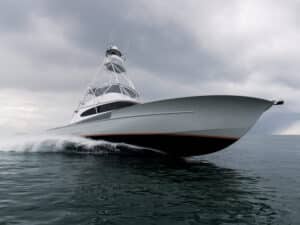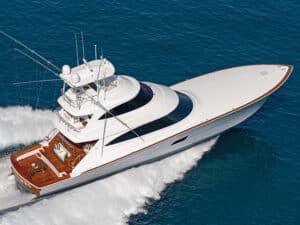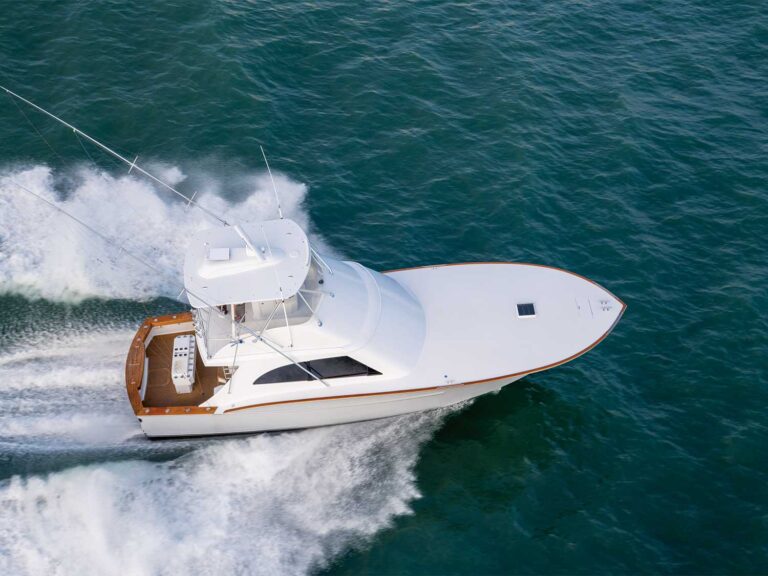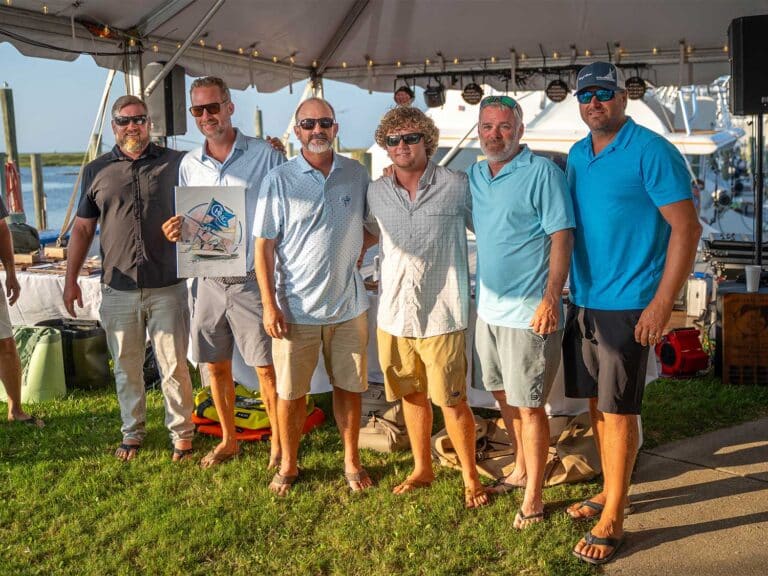In 1959, Hatteras Yachts debuted its first boat. Now called Knit Wits, it is still in remarkably Bristol condition. I fished it not long ago and found it to be an exquisite piece of work. Consider that Hatteras Yachts has had 38 years to perfect a product that was nearly perfect at the company’s founding, and you can well imagine that the newest member of the Hatteras family, a 60-foot convertible now in construction, will be an absolute treat for all your senses.
Construction
No one has ever accused Hatteras of building lightweight boats – either in construction or reputation. A solid fiberglass bottom with vinylester resin assures the toughest, most durable barrier between your investment and the deep blue sea. Moving up the hull sides, weight is diminished through the use of Divinycell coring, fiberglass and polyester resins. However, though the structural bulkheads throughout the 60 also receive the Divinycell, cabin bulkheads remain solid, fine woods, and the joiner work has all the telltale signs of old-world craftsmanship.
Performance
Every good naval architect will tell you that a well-rounded offshore vessel must achieve a delicate balance between light weight for speed and fuel economy and heavy weight for sea-kindliness. Certainly a 60-footer that weighs as little as most 35- to 40-footers can be extremely fast. But put that boat into a nasty head sea and it can damage both the boat and the crew. Hatteras combines weight, beam, length of running surface and bottom design to provide both exceptionally smooth head-sea ride with a respectable turn of speed.
The new 60 offers three different power packages: Detroit 12V-92TAs at 1,104 hp, Detroit 16V-92TAs at 1,472 hp and the CAT 3412C TAs at 1,649 hp. For the sake of argument, we’ll choose the performance specification of the midsize engine package. With these DDEC 16V92TAs, you could expect a top speed of 35 knots and a cruise of 32 knots.
Layout
The first thing I’ve always noticed when boarding a Hatteras is the sophistication of the interior decor. Hatteras decorators are unsurpassed. You never see the garish, bordello-type designs, but rather rich, high-class fabrics, furniture and appointments. Whether you are entertaining guests for a dress-up party or napping on the sofa on the way out to the canyons, you’re sure to appreciate the comfort and space the salon offers. Wide and wide open, the well-designed area assures that guests and galley-slaves are never separated. And if you happen to be the slave making lunch while trolling, you can always see the trolling spread and be in the cockpit in seconds when a line leaves a rigger clip.
Like all Hatteras boats, the 60 boasts a galley that will be far better equipped than many homes, including specially designed glass and bottle storage, combination convection/microwave oven and loads of refrigerator and freezer space.
Belowdecks you’ll find three staterooms, two with queen-size berths and one with over/under bunks. However, all have private heads with separate shower stalls.
As to the heart and nerve centers of any sport-fishing boat – the flybridge, engine room and cockpit – any competitive fishing team would be honored to work such a boat. The cockpit’s huge bait freezer assures that you’ll have plenty of bait, no matter how remote the fishing spot. Optional fish-box freezers can keep fish on ice or iced-brine for optimum freshness. And of course, a complete bait-prep center and loads of storage mean you can always have the right tackle and equipment near at hand.
The flybridge provides refrigeration for drinks, abundant guest seating forward of the helm, and a broad expanse of flush-mounted and overhead electronic instrument space. Another great feature – the flybridge overhang – discards the need for a fold-up sunshade over the forward end of the cockpit, shelters the anglers sitting on the cockpit boxes and provides the ideal spot for semi-hidden cockpit lighting fixtures.
Perhaps the best thing about buying a Hatteras is security. You know what you’re buying, you know that it’s a good, solid investment, and you know that you have a world-class fishing machine under you. Such knowledge is very comforting when you’re 100 miles out to sea.







